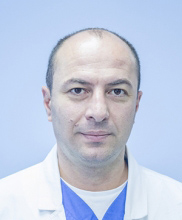A patient G.Y., 1944 y/b, in 28.03.2018 has admitted to Erebouni MC with pronounced cachexia due to non-digestion of food. The patient underwent a contrast CT examination that revealed a giant deformed abdominal aortic aneurysm, as well as a subtotal occlusion of the orifice of the superior mesenteric artery, which was the cause of malabsorption and cachexia. Aneurysmal lesion included most of the abdominal aorta up to the bifurcation of the iliac arteries, which were also deformed and enlarged.
Due to total gastrointestinal ischemia, malabsorption and cachexia, the risk of surgical correction of an aneurysm of the abdominal aorta and iliac arteries was considered unjustified. It was decided first to provide adequate blood supply to the gastrointestinal tract endovascularly in order to bring out the patient from the state of cachexia and prepare for the next stage of surgery-correction of the aneurysm.
In 29.03.2018 Head of Department of Angiography and Intervention Cardiology Merujan Saghatelyan, MD in angiographic laboratory of MC Erebouni carried out angioplasty of the superior mesenteric artery. The left brachial access was the only possible way, since the right brachial and axillary arteries were also extremely deformed. An 8-French long introducer was carried from the left brachial artery to the abdominal aorta, which was complicated due to tortuosity of the left subclavian artery and thoracic aorta. Diagnostic angiography of the mesenteric artery revealed a subtotal stenosis of the orifice of superior mesenteric artery. In the affected part of the artery, 0.014 'conductor was managed to carry, on which the orifice stenosis was dilated with a 4.5 mm balloon. After predilatation, a 4.5 drug-eluting stent was implanted in the narrowed part, followed by balloon postdilatation. However, the radial force of the implanted stent was insufficient to counteract fibrous stenosis. After stent placement, a rather significant residual stenosis remained. Persistent opening of the orifice of mesenteric artery was achieved by implantation of the second peripheral stent NEPTUN 6.0x59 on a 0.035 'conductor followed by postdilatation. After the procedure the main blood flow along the superior mesenteric artery and all its distal branches has been fully restored.
The patient's condition after the angioplasty was immediately improved: the next day there was an appetite and adequate digestion of food.
Isolated cases of angioplasty and stenting of the superior mesenteric artery were carried out in Armenia. This intervention requires high professionalism of specialists and high-tech equipment, which provides good results, an example of which was the case described above.



